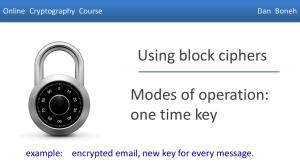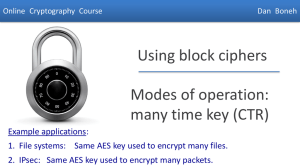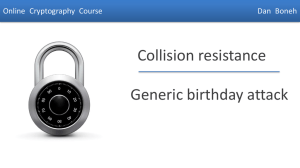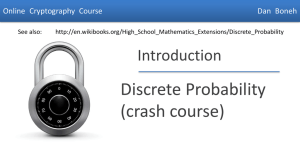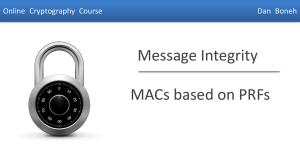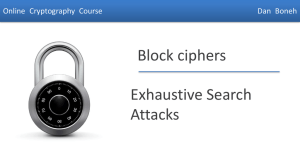04.3-using-block
advertisement
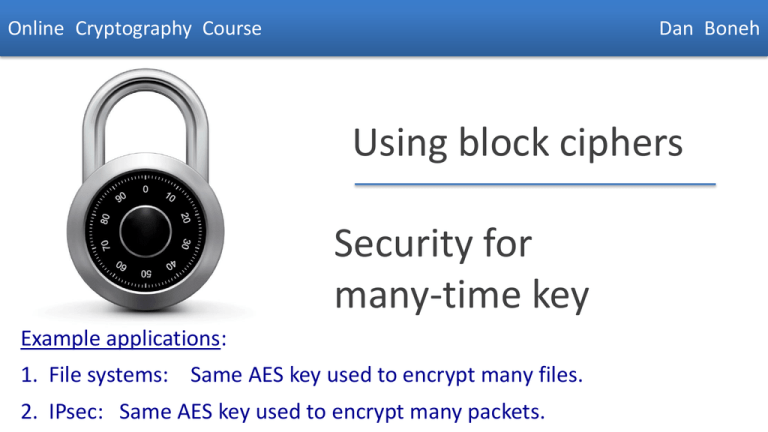
Online Cryptography Course
Dan Boneh
Using block ciphers
Security for
many-time key
Example applications:
1. File systems: Same AES key used to encrypt many files.
2. IPsec: Same AES key used to encrypt many packets.
Dan Boneh
Semantic Security for many-time key
Key used more than once ⇒ adv. sees many CTs with same key
Adversary’s power: chosen-plaintext attack (CPA)
• Can obtain the encryption of arbitrary messages of his choice
(conservative modeling of real life)
Adversary’s goal: Break sematic security
Dan Boneh
Semantic Security for many-time key
E = (E,D) a cipher defined over (K,M,C).
b
For b=0,1 define EXP(b) as:
Chal.
kK
Adv.
m1,0 , m1,1 M : |m1,0| = |m1,1|
c1 E(k, m1,b)
Dan Boneh
Semantic Security for many-time key
E = (E,D) a cipher defined over (K,M,C).
b
For b=0,1 define EXP(b) as:
Chal.
kK
Adv.
m2,0 , m2,1 M : |m2,0| = |m2,1|
c2 E(k, m2,b)
Dan Boneh
Semantic Security for many-time key
E = (E,D) a cipher defined over (K,M,C).
b
Chal.
kK
(CPA security)
For b=0,1 define EXP(b) as:
for i=1,…,q:
Adv.
mi,0 , mi,1 M : |mi,0| = |mi,1|
ci E(k, mi,b)
b’ {0,1}
if adv. wants c = E(k, m) it queries with mj,0= mj,1=m
Def: E is sem. sec. under CPA if for all “efficient” A:
AdvCPA [A,E] = |Pr[EXP(0)=1] – Pr[EXP(1)=1] |
is “negligible.”
Dan Boneh
Ciphers insecure under CPA
Suppose E(k,m) always outputs same ciphertext for msg m. Then:
Chal.
kK
So what?
m0 , m 0 M
c0 E(k, m0)
m0 , m 1 M
c E(k, mb)
Adv.
output 0
if c = c0
an attacker can learn that two encrypted files are
the same, two encrypted packets are the same, etc.
• Leads to significant attacks when message space M is small
Dan Boneh
Ciphers insecure under CPA
Suppose E(k,m) always outputs same ciphertext for msg m. Then:
Chal.
kK
m0 , m 0 M
c0 E(k, m0)
m0 , m 1 M
c E(k, mb)
Adv.
output 0
if c = c0
If secret key is to be used multiple times
given the same plaintext message twice,
encryption must produce different outputs.
Dan Boneh
Solution 1: randomized encryption
• E(k,m) is a randomized algorithm:
m0
enc
dec
m1
m0
m1
⇒ encrypting same msg twice gives different ciphertexts (w.h.p)
⇒ ciphertext must be longer than plaintext
Roughly speaking: CT-size = PT-size + “# random bits”
Dan Boneh
Let F: K × R ⟶ M be a secure PRF.
R
For m∈M define E(k,m) = [ r⟵R,
output (r, F(k,r)⨁m)
]
Is E semantically secure under CPA?
Yes, whenever F is a secure PRF
No, there is always a CPA attack on this system
Yes, but only if R is large enough so r never repeats (w.h.p)
It depends on what F is used
Solution 2: nonce-based Encryption
nonce
Alice
m, n
E
k
E(k,m,n)=c
Bob
c, n
D
D(k,c,n)=m
k
• nonce n: a value that changes from msg to msg.
(k,n) pair never used more than once
• method 1: nonce is a counter (e.g. packet counter)
– used when encryptor keeps state from msg to msg
– if decryptor has same state, need not send nonce with CT
• method 2: encryptor chooses a random nonce, n N
Dan Boneh
CPA security for nonce-based encryption
System should be secure when nonces are chosen adversarially.
b
Chal.
kK
for i=1,…,q:
ni
Adv.
and mi,0 , mi,1 : |mi,0| = |mi,1|
c E(k, mi,b , ni)
b’ {0,1}
All nonces {n1, …, nq} must be distinct.
Def: nonce-based E is sem. sec. under CPA if for all “efficient” A:
AdvnCPA [A,E] =
|Pr[EXP(0)=1] – Pr[EXP(1)=1] |
is “negligible.”
Dan Boneh
Let F: K × R ⟶ M be a secure PRF.
Let r = 0 initially.
For m∈M define E(k,m) = [ r++, output (r, F(k,r)⨁m)
]
Is E CPA secure nonce-based encryption?
Yes, whenever F is a secure PRF
No, there is always a nonce-based CPA attack on this system
Yes, but only if R is large enough so r never repeats
It depends on what F is used
End of Segment
Dan Boneh
